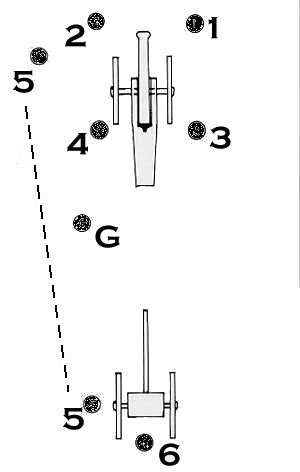|
ARTILLERY DRILL
~ Saftey Rules ~
Field artillery was organized in batteries. Although it varied from time to time, a battery Usually consisted of six of the same kind of cannons.
Regulations prescribed a captain as a battery commandeer. A battery would have three sections: left, right, and center. Four lieutenants served under the captain. Six noncommissioned officers were mounted to direct the movement of each piece. There was also a bugler.
Each gun had a crew that consisted of seven men. This included the "gunner" who was the chief of the piece, the chief of caisson and six artillerymen who were all assigned numbers for servicing the piece.
A light artillery battery consisted of forty-eight men at full regulation strength.
A trained and disciplined battery could come into action and fire its first shot in well under one minute. Depending upon the terrain, a 14-yard space between the cannons was called for in the regulations.
Cannoneers took their positions as in the diagram shown..
|
|
 |
At the command "Commence firing," the gunner ordered "Load."
Number 1 (the Rammer) sponged the tube, while
Number 3 (the Pick) held his thumb on the vent..
Number 2 (the Wormer) took a round from
Number 5 (the Powder Monkey) and placed it in the muzzle.
Number 1 rammed the round home, again with Number 3 holding his thumb on the vent.
The gunner sighted the cannon.
When the gun was loaded, Number 3 moved to the trail and moved it left or right with the trailspike as directed by the gunner.
Number 5 got another round from
Number 6 at the limber where 6 cut fuses (if needed) for shell and/or case.
The gunner stepped clear to the side of the piece to observe the effect of fire, and gave the command "Ready."
Numbers 1 and 2 stepped clear and placed implements on the wheel hubs.
Number 3 punctured the cartridge with the vent pick.
Number 4 (the Firer) attached the lanyard to a friction primer and inserted the primer in the vent.
At nod from Number 4 Number 3 stepped clear.
When ready the gunner gave command "Prepare,"
Number 4 pulled the lanyard taut. Numbers 1 and 2 bring down implements and cover.
Number 4 signs that he is ready.
At the gunner's command "Fire,"
Number 4 yanked the lanyard firing the piece.
The gunner ordered the cannon run back up and the process was repeated until the command "Cease firing. "
Good smoothbore crews could fire two aimed shots per minute with fixed ammunition. When firing canister, the rate of fire could be doubled, but this was often at the risk of not sponging the barrel between rounds. Sponging not only helped to cool the tube, but more importantly, it extinguished any smoldering cartridge bag remains. Against charging infantry, however, the chance of premature explosion was worth taking as opposed to the capture of the gun.
|